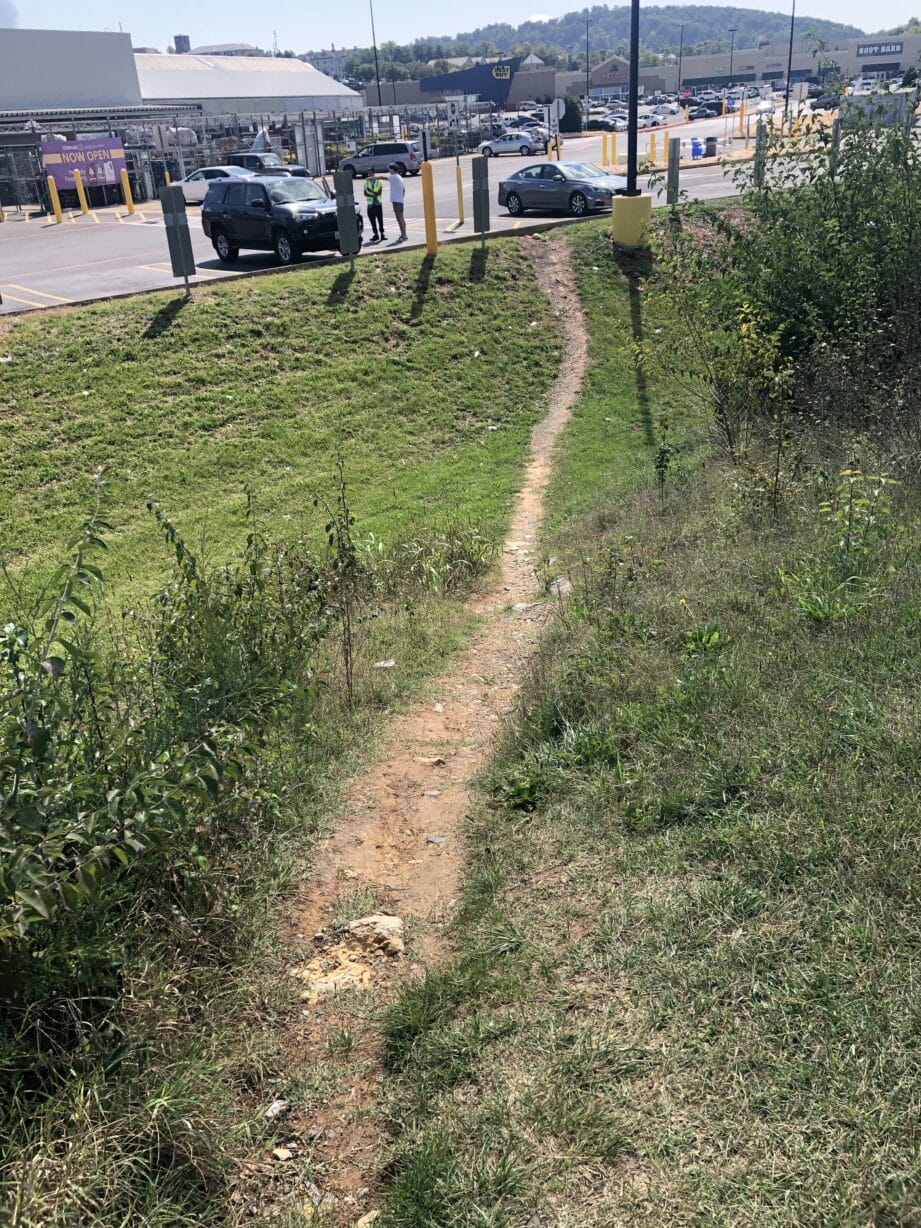
By Sofia Samatar
“The Friendly City” is a weekly column about walking in Harrisonburg that will run during 2024. Each week, your friendly correspondent, writer and teacher Sofia Samatar, will reflect on a walk in our city.
They are walking up the path that leads from the busy road to the trees. Their sneakers bounce on the tarmac that looks almost purple against the smooth green grass. Car keys jostle in their pockets. Their backpacks shift with the rhythm of their steps. They are heading to class at the big university beyond the pines.
They are crossing the highway on the overpass, staying close to the railing. Cars rush past them. On the far side, the railing, this marker of safety, becomes an enemy, as they have to climb over it, balanced on one foot on the small strip of gravel beside the road, in order to reach the shopping plaza. For a moment they teeter there, struggling, the parents just home from work, the kids who seem too small to get over the railing, in danger for a terrifying instant of falling into the oncoming traffic. Then they are on the other side. They go down the steep dirt path, walking slowly, sideways, arms out to keep themselves steady, among the weeds, the faint lavender bubbles of crown vetch, the spotted lanternflies that plummet down on them from the tall pole of the streetlight. The path dips to its lowest point, then slopes sharply upward. They climb, passing the smashed watermelon some other shopper has dropped, its red flesh riddled with ants. They reach the parking lot, brush down their clothes to knock off any lingering bugs, and continue toward the doors of the giant store.
We are in the realm of desire paths, on Reservoir Street at the plaza dominated by the Walmart Supercenter.
Desire paths are informal trails worn down by the passage of people or animals. They mark the most efficient routes between locations. They are unplanned, but persistent: as vegetation is rubbed away and the paths become clearer, more walkers use them, and the increasing foot traffic deepens the track in the landscape.
Here on Reservoir Street, observing the two sides of this bustling four-lane road between the shopping plaza and the university, we can see the two responses planners generally take to desire paths. Sometimes the responsible authorities listen to desire. They pave the insistent, unforeseen paths that spring up from the texture of daily life, recognizing them as an expression of the wisdom of the crowd. This is what’s happened between the shopping plaza and the university, where students carved a line down the hill to the crosswalk, repeatedly tramping toward the cheap goods at Walmart and the big lot where they park their cars, avoiding the high campus fees. Their track was paved, made safe and easy to walk. But on the other side, the one that gives on a community of townhomes and apartments, we can see the alternate response. Here, desire is ignored. The sidewalk that crosses the overpass abruptly ends. A railing blocks the way.
In Finland, I read, city planners wait for the snow to fall before they create public paths. They follow the tracks left by desire. In London, there is an architect who regards dropped cigarette butts and discarded gum as signs of where to place a bench.
There’s something beautiful about this harmony between designers and the public, between abstract maps and concrete footsteps, between boardroom blueprints and lived reality, between planning and experience.
Of course the people living in the community that borders Reservoir Street could take an alternate path to the shopping plaza. To be safe, they should walk down to the light at Martin Luther King Jr. Way, cross Market Street on the crosswalk, cross back over Reservoir Street, cross back over Market Street, walk up the hill on the sidewalk, use the crosswalk at Eastover Drive, and then continue over the overpass, eventually meeting up with the students’ desire path at the traffic light. This adds about twenty minutes to the walk. Instead of reaching the plaza in ten minutes, they will get there in half an hour. Instead of twenty minutes to go to the store and back, they will have to set aside one hour. For half that time, they will have to carry their laden shopping bags.
Having been, for some years, a full-time working mom, I can attest to the immense difference between twenty minutes and an hour.
But the desire path doesn’t listen to me or you. It heeds a need. It responds to hunger. It is not exactly against authority; authority doesn’t figure in its calculations. It is not interested in the plan. The signs, the arrows, the helpful warnings placed in its environment, the regular stripes of the zebra crossing, the sidewalk, the traffic light—these signals surround the path without addressing it, like a kind of ambient noise. It will only understand them when they align with its goals, which spring from the impeccable logic of here and now, of this apartment and its precise spatial relationship with that grocery aisle, of these minutes leaking away from the clock, these clamoring kids, this shopping list, this fridge that is missing four essential ingredients, this tiredness, this heat or rain, and these muscles that can definitely, certainly, walk a few more necessary steps.
To all of this the desire path listens closely. It leaps up from the cityscape. It flickers over obstacles like a flame. It is so vigorous, so eager, so almost joyful in its progress, it seems as if it might zip right through the shopping plaza, as if it’s bent on some clandestine and visionary errand, heading straight for the mountains, or into another life.
With thanks to The Friendly City Urbanist












